Cardiac Stretch–Activated Channels and Mechano-Electric Coupling
The processes that underlie excitation-contraction coupling (ECC; see chapter 16), as well as contractile activity of cardiac muscle, form major foci of basic and applied research. In contrast, the relevance of the mechanical environment for cardiac electrical activity—mechano-electric coupling (MEC)—is often overlooked or ignored. Thus, mechano-electric dissociation is often introduced in experimental research on purpose, by applying pharmacologic uncouplers, to reduce or abolish motion artifacts that interfere with the fidelity of electrical signals, even though this uncoupling alters observed electrical behavior.1 In conceptual terms, cardiac MEC complements ECC, integrating cardiac electrical and mechanical activity into an intracardiac regulatory loop (Figure 14-1).
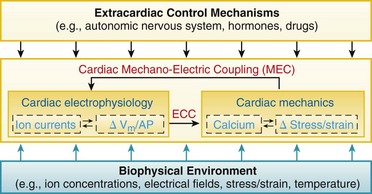
Figure 14-1 Schematic view of cardiac electromechanic integration. Within the heart (center box), electrical behavior steers mechanical activity via excitation-contraction coupling (ECC) but, in turn, it is affected by mechano-electric coupling (MEC). This involves a multitude of interdependent feed-forward and feed-back pathways that alter transsarcolemmal and intracellular ion transport, membrane and action potential configuration (ΔVm/AP), calcium handling, and stress–strain dynamics. Intracardiac electromechanic interactions are modulated by the biophysical environment of the heart (bottom box), and form a target of extracardiac control (top box).
In fact, manifestations of cardiac MEC are present at all levels of structural and functional integration, from in situ and ex vivo whole heart, over in vitro tissue and cells, to subcellular domains such as membrane patches. Indeed, patch-clamp identification of cardiac stretch-activated ion channels (SACs) by Guharay and Sachs2 was pivotal not only for the development of quantitative insight into mechanisms underlying MEC, but also for the advancement of the topic beyond the perception of a scientifically ill-founded clinical curiosity. This chapter will discuss acute electrophysiologic responses of the heart to mechanical stimulation and the involvement of SAC.
Functional Relevance of Cardiac Mechano-Electric Coupling
Effects of cardiac mechanical stimulation on heart rate and rhythm have been reported in the medical literature for more than a century. To name a few key contributions: pioneering work by Felice Meola2a and Ferdinand Riedinger2b in the late nineteenth century identified Commotio cordis (or Commotio thoracica) as an independent pathologic entity where cardiac rhythm disturbances of varying severity are initiated by nonpenetrating mechanical stimulation of the precordium in the absence of visible structural damage to the heart. In the early twentieth century, Eduard Schott29 reported that precordial fist thumps can be used to pace otherwise asystolic ventricles, such as in Adams-Stokes syndrome. At the same time, Francis Bainbridge2c famously identified the positive chronotropic response of the heart to increased venous return.
Mechanical Induction of Nonphysiologic Rhythms
The fact that mechanical stimuli of sufficient amplitude can be used to pace otherwise quiescent hearts has been illustrated by Franz et al., using Langendorff-perfused rabbit heart preparations where the ventricles (rendered asystolic by ablation of the atrioventricular node) were stimulated by periodic inflation of an intraventricular balloon (Figure 14-2, A).
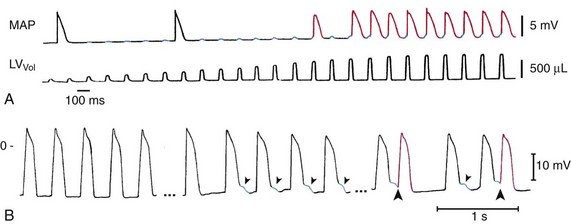
Figure 14-2 Mechanically induced premature ventricular beats (PVB). A, Mechanical pacing of the Langendorff-perfused asystolic rabbit heart. Pulsatile left-ventricular (LV) distention (bottom trace, showing increasing LV balloon inflation) causes diastolic membrane depolarization (top trace, blue highlights). The amplitude of depolarization increases with the mechanical stimulus and, upon reaching threshold levels, gives rise to the generation of action potentials (APs; top trace, red) with each volume pulse. Note that the first two APs are spontaneous escape beats, unrelated to the mechanical stimuli. B, Cardiac contraction–induced tissue depolarization (blue) and PVB induction (red) in patients. MAP recording before (left) and during (middle and right) inflation of a balloon in the right-ventricular outflow tract, which gives rise to early afterdepolarization-like events (blue) and PVB-induction (red). LVVol, volume pulses; MAP, monophasic AP. (A, From Franz MR, Cima R, Wang D, et al: Electrophysiological effects of myocardial stretch and mechanical determinants of stretch-activated arrhythmias. Circulation 86:968–978, 1992. B, From Levine JH, Guarnieri T, Kadish AH, et al: Changes in myocardial repolarization in patients undergoing balloon valvuloplasty for congenital pulmonary stenosis: evidence for contraction-excitation feedback in humans. Circulation 77:70–77, 1988.)
Similar behavior is believed to underlie “fist pacing” in asystolic patients. Energy levels required for mechanical PVB induction by precordial impact have been established by defibrillation pioneer Zoll et al.3 in human volunteers as 0.04 to 1.5 J. For comparison, the lower end of this energy range is equivalent to dropping a golf ball (46 g) from a height of 9 cm (3.5 in).
The study by Zoll et al.3 found that, in anaesthetized dogs, impacts with energies tenfold greater than the PVB-induction threshold do not induce repetitive responses, ventricular tachycardia (VT), or VF, even if applied in the relative refractory period.3 Overall, this is in keeping with the notion that arrhythmogenesis requires the combination of trigger and sustaining mechanisms, so that consequences of isolated ectopic beats, whether mechanically induced or not, are usually benign.
Although these examples illustrate the effects of the external mechanical environment on cardiac MEC (see Figure 14-1, bottom box), mechanical PVB induction can also arise because of the heart’s own contractile activity (see Figure 14-1, middle box). This is illustrated in Figure 14-2, B, which shows MAP recordings from a patient undergoing pulmonary balloon valvuloplasty. In this procedure, the stenosed RV outflow valve is widened by insertion and inflation of a balloon. During balloon inflation, RV contractions are isovolumic (no ejection) and give rise to significantly increased RV peak-pressures. This increase is generally associated with AP-shortening, diastolic depolarization, and occurrence of early afterdepolarization (EAD)-like events. If supra-threshold, these depolarization can give trigger PVB.4 As before, against an otherwise inconspicuous myocardial background, self-sustained repetitive activity is not normally induced.
In contrast, in the presence of preexisting pathologies, PVB can give rise to sustained arrhythmias, as shown in whole-animal studies of pathologically prolonged QT intervals, conducted by Volders et al. In their model, QT-prolongation was induced acutely by pharmacologic block of the slowly activating delayed rectifier potassium current. On this background, additional β-adrenergic stimulation by bolus injection of isoproterenol gives rise to ventricular after contractions of increasing amplitude (up to 25 mm Hg). Originating from near-endocardial locations, their onset precedes (by tens of milliseconds) EAD-like epicardial potentials and alterations in descending T-wave morphology. With increasing amplitude, these apparently contraction-induced afterdepolarizations eventually reach threshold for PVB-induction, followed by torsades de pointes arrhythmic activity.5
Under certain conditions, acute mechanical stimulation can be sufficient to give rise to both trigger and sustaining mechanisms for maintained arrhythmias, even in otherwise healthy myocardium. A prominent example of this is Commotio cordis. A number of risk factors for the mechanical induction of such rhythm disturbances have been identified, based on experimental observations from the pioneering work of Schlomka6 to modern studies by Link.7 Key risk factors include (1) type of impact (impulse-like stimulation, whose arrhythmogenic risk is inversely related to projectile compliance and contact area); (2) impact energy (large subcontusional forces, reaching more than 100 J in competitive sports); (3) impact location (precordial, or in human also spinal, areas that offer efficient energy transmission from body surface to myocardium); and (4) impact timing. Factors 1 to 3 can be regarded as permissive: only if they are all present does timing become decisive.8 This presumably explains why the vast majority of precordial (or spinal) impacts result in relatively benign heart rhythm changes, if any.
The critical time-window for the worst possible outcome of Commotio cordis, induction of VF, overlaps with the T wave. The T wave, during which myocardial electrophysiologic heterogeneity is maximal, has long been associated with a period of increased susceptibility to arrhythmogenesis by electrical stimulation, the so-called vulnerable window. Compared with electrical stimulation, the vulnerable window for mechanical VF-induction is surprisingly narrow (∼15 ms, just before the peak of the T wave in anaesthetized pig).9
Quantitative computational modeling suggests that mechanically induced VF is favored during a short period of time only, when the mechanically stimulated tissue volume overlaps with the trailing wave of excitation.10,11 In this setting, sustained arrhythmogenesis occurs because, in addition to mechanical PVB induction in tissue that has regained excitability (trigger), the intersection of mechanically affected myocardium and the trailing repolarization wave gives rise to a functional block zone around which reentry develops (sustaining mechanism; Figure 14-3). In three-dimensional tissue, the ectopic activation front forms around a transmurally directed conelike volume of tissue in which mechanical activation reaches the AP threshold.12 The more forceful the impact, the closer to fully transmural is the affected tissue cone. In addition, the more focal the stimulus, the closer to perpendicular is this ectopic wavefront, relative to the cardiac surface and, by implication, to the trailing wave-end. This relationship enhances the arrhythmogenic potential, as seen in classic S1/S2 cross-stimulus experiments, and could hold a key to understanding risk factors 1 and 2.
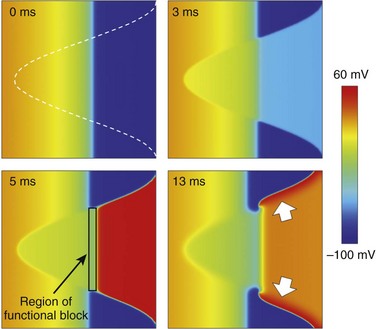
Figure 14-3 Effect of local mechanical stimulation during the critical window of the T wave in a two-dimensional model of ventricular free wall consisting of 256 × 256 electrotonically coupled guinea pig ventricular cell models. A local impact to the epicardium (right-hand side of the grid), timed to occur at 40% tissue repolarization (see trailing wave-end of the previous activation, which travels from right to left; for color-coding, see scale bar), stimulates cation nonselective stretch-activated channels in the mechanically affected tissue (white outline, top left panel). This gives rise to depolarization in tissue that has regained excitability and early repolarization of tissue with positive membrane potentials (top right panel). If suprathreshold, stretch-induced depolarization causes ectopic excitation (bottom left panel). The intersection of trailing wave and mechanically induced new excitation forms a functional block zone. This causes the formation of two wave fronts that progress across the tissue near perpendicularly to the normal direction of electrical wave propagation (bottom-right, see white arrows) and give rise to the formation of two stable reentrant rotors of excitation. (Data from Garny A, Kohl P: Mechanical induction of arrhythmias during ventricular repolarisation: modelling cellular mechanisms and their interaction in 2D. Ann N Y Acad Sci 1015:133–143, 2004.)
In contrast to acute effects, MEC-contributions to arrhythmogenesis in chronic cardiac overload are more difficult to uncover. Usually, pathologies that involve cardiac pressure or volume overload develop slowly, and they are associated with pronounced structural and functional remodeling. In addition, the causes of overload and tissue remodeling could be proarrhythmogenic in their own right. Nonetheless, mechanical factors have been implicated in the domestication of atrial fibrillation (AF),13 whose dominant frequency in patients correlates with atrial pressure.14 Similarly, ventricular arrhythmogenesis has been linked to pressure and volume overload.15,16
A conceptually interesting approach to probing the relevance of mechanical factors for arrhythmogenesis in the chronically overloaded heart is the temporary removal of tissue strain. This can be achieved with the Valsalva maneuver, an attempt to forcefully exhale against the closed glottis. Intrathoracic pressure increases during the strain phase of the maneuver, reducing venous return and favoring arterial drainage from the chest. This condition leads to measurable reductions in cardiac dimensions. On this background, VT has been found to convert to sinus rhythm.17 In this study, 7 of 15 patients showed sustained and 2 showed transient cardioversion. Relief of ventricular wall stress, rather than autonomic nervous system–mediated responses, appears to be a causal contributor to this antiarrhythmic effect, because successful cardioversion can also be observed in the presence of pharmacologic17 or surgical denervation of the heart, such as in transplant recipients.18
Thus, acute stretch can cause diastolic depolarization, which can trigger ectopic excitation. Systolic or sustained stretch can contribute to arrhythmia sustenance by enhancing heterogeneities in excitability, refractoriness, and electrical load. These MEC effects have implications for preventive measures (e.g., chest protector design for sports involving fast-moving projectiles) and for interventions such as hemodynamic unloading, active and passive cardiac assist, or biventricular pacing. In addition, defibrillation threshold increases with ventricular preload,19 apparently not only because of geometric factors,20 but also because of regionally differing MEC-mediated strain effects that raise background electrophysiologic heterogeneity.21 Cardiac mechanosensitivity therefore adds an interesting dimension to the present discussion about whether a period of chest compressions should precede defibrillation attempts in cardiac arrest victims with prolonged delays to intervention.
Mechanical Termination of Nonphysiologic Rhythms
Acute mechanical stimulation, usually by precordial thump (PT), can be used as a means of cardiopulmonary resuscitation. PT has been reported to terminate arrhythmias, including asystole, VT, and rarely VF (Figure 14-4).
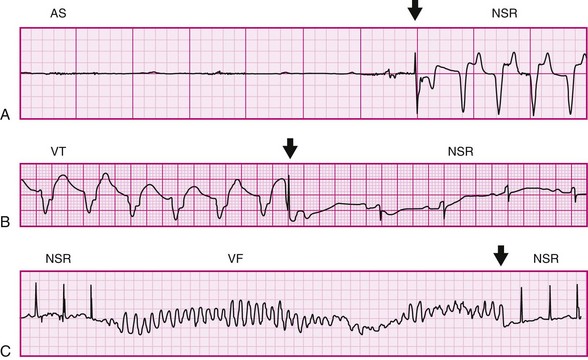
Figure 14-4 Electrocardiograph recordings of precordial thump (PT)-induced cardioversion in patients. A, Conversion of ventricular asystole (AS) to normal sinus rhythm (NSR) by PT. B, PT-conversion of ventricular tachycardia (VT). C, PT-induced termination of early ventricular fibrillation (VF). Arrows indicate PT application. (A, From Pellis T, Kette F, Lovisa D, et al: Utility of precordial thump for treatment of out of hospital cardiac arrest: a prospective study. Resuscitation 80:17–23, 2009. B, From Pennington JE, Taylor J, Lown B: Chest thump for reverting ventricular tachycardia. N Engl J Med 283:1192–1195, 1970. C, From Barrett JS: Chest thumps and the heartbeat. N Engl J Med 284:393, 1971.)
In the emergency resuscitation setting, PT is often the fastest resuscitative procedure available. PT is delivered with the ulnar side of the clinched fist, from a height of approximately 20 cm (8 in), followed by active retraction to emphasize the impulse like nature of the stimulus. The energy levels required for PT-based termination of VT and VF are one to two orders of magnitude higher than those involved in mechanical pacing of the acutely asystolic ventricle (4 to 10 J vs. 0.04 to 1.5 J in adults).22 The more powerful thumps are applied preferentially to the lower sternum, rather than the left sternal edge, which is targeted for fist-pacing or precordial percussion.23
Efficacy of PT in real-life settings is difficult to calibrate and compare, because patient backgrounds vary, mechanical impact properties are not normally monitored, controlled study designs are not usually possible, and single case reports in particular suffer from positive data publication bias. The available information from case series involving tens24 to 100 patients25 suggest that fist-pacing of the bradycardic heart has higher success rates (up to 90%)25 than PT-version of tachyarrhythmias (1% to 60%).24,26 Only three small prospective studies have investigated the clinical utility of PT.26–28 They showed that PT is ineffective in most tachyarrhythmias, that acutely-asystolic arrest (for which PT was initially described in 1920)29 may be the most amenable target for mechanical cardioversion, and that negative side effects are rare (none in >700 cases).26–28
In cases where PT causes successful termination of tachyarrhythmias, it is believed to act primarily via depolarizing excitable tissue in the excitable gaps.30 However, as these gaps may be in myocardium at sites distant from the tissue underneath the precordium, high PT energy levels are necessary and, if there is a multitude of them (e.g., in VF), positive outcomes are rare.
In the asystolic heart, fist-pacing can trigger cardiac excitation and active contraction. The hemodynamic efficacy of such mechanically induced cardiac contractions is not different from electrically stimulated beats,31 and both are about twice as productive (in terms of volume output) as chest compressions, even if performed optimally.32 This efficacy confers resuscitatory value to fist-pacing even when normal sinus rhythm is not immediately reinstated; of course, PT should not delay implementation of other established resuscitation measures.
The most common manifestation of PT effects in ECG recordings, in particular in the asystolic heart, is an impact-induced electrical artifact with an electrical axis that tends to resemble the direction of normal QRS-complexes. This manifestation suggests that mechanically induced excitation in the quiescent heart can proceed along a pathway that has an overall trajectory similar to that of normal activation. It is possible, therefore, that earliest excitation is triggered preferentially either in cells of the secondary/tertiary pacemaker/conduction tissue of the heart (e.g., Purkinje fibers that have long been known to be mechanosensitive),33 or in subendocardial locations, which appear to be more mechanosensitive than subepicardial tissue.5 This possibility is supported by transmural differences in expression levels of potassium-selective SAC (SACK) such as TREK-134 and cation nonselective SAC (SACNS) such as TRPC1.35
Overall, the range of cardiac electrophysiologic responses to mechanical stimulation is not principally different from those caused by electrical energy delivery. Both can be used to pace, cardiovert, or arrest the heart. Concepts such as the vulnerable window for VF-induction apply to both electrical and mechanical stimuli. Even the effective energy ranges required for pacing, cardioversion and defibrillation are not entirely dissimilar. For example, external electrical defibrillation is usually achieved by extracorporeal energy application of 150 to 250 J; of this, only 4% traverses the heart,36 yielding a cardiac energy delivery of 6 to 10 J, similar to that for the PT-version of tachyarrhythmia. These similarities should not be surprising, because mechanical energy can be converted into a transmembrane current by ion fluxes through SAC at the intervention’s target site: the cardiac cell.
Mechanical Modulation of Pacemaking
Diastolic stretch of cardiac tissue causes membrane depolarization, if strong enough to induce any change. In working myocardium, such depolarization may trigger PVB (see Figure 14-2), while in conduction33 and pacemaker tissue37 of many species an increase in beating rate (BR) is observed (Figure 14-5). This positive chronotropic response to stretch is seen predominantly in mammals with low resting heart rates, such as guinea pigs, rabbits, cats, dogs, and humans. In fast-beating murine hearts, in contrast, sustained stretch reduces BR, although apparently via the same underlying mechanism: SACNS activation.38
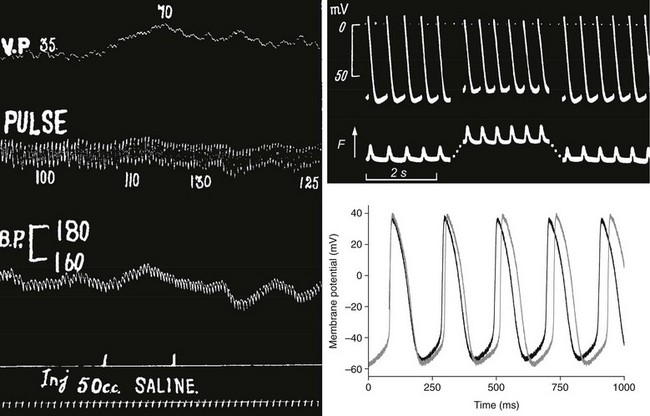
Figure 14-5 Positive chronotropic response to stretch in whole animal, isolated tissue, and single pacemaker cell. Left, Classic observation by Francis Bainbridge, showing that intravenous injection of saline (bottom)







